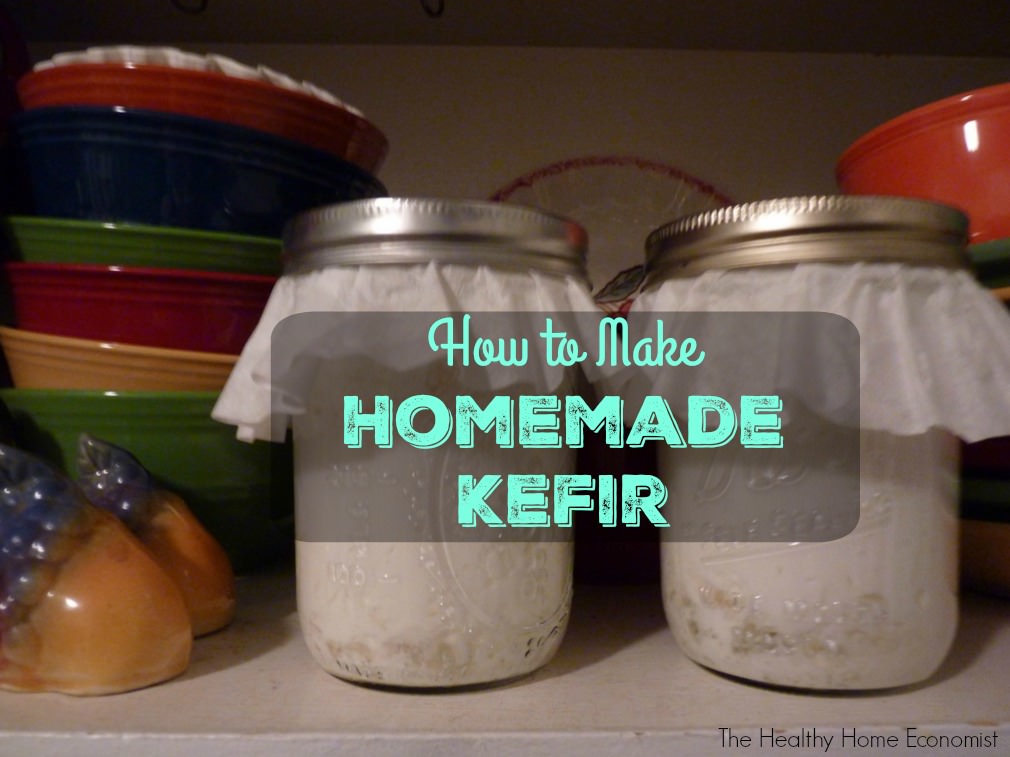Table of Contents[Hide][Show]
How to make homemade kefir the traditional way by fermenting on the counter for 24 hours with farm fresh milk.

I prefer homemade kefir to yogurt because yogurt only has 2-5 strains of beneficial bacteria None of these aggressively attack and destroy pathogens in the gut like the probiotics in kefir do.
By the way, kefir is pronounced ku-feer (not kee-fer or ke-fer).
Kefir made at home has dozens of beneficial bacterial strains as well as several beneficial yeasts. Kefir compared to yogurt is no competition. Kefir is much more beneficial for gut healing.
The one catch is that you need to learn how to make kefir yourself!
Commercial kefir brands typically have far less microbial strains and are not fermented long enough to have the same benefits.
Homemade Kefir Benefits
In a gut that is dominated by pathogens and candida overgrowth (as in someone who has taken many rounds of antibiotics and other prescription drugs over the years and/or eats primarily processed foods), yogurt tends to have only a temporary beneficial impact.
As mentioned earlier, homemade kefir has about 30 beneficial strains of bacteria and yeasts that do aggressively recolonize the gut by destroying pathogens.
As a result, kefir has the potential to permanently alter the gut environment for the better whereas yogurt does not.
The best way to make homemade kefir is to obtain live kefir grains from a friend. They grow slowly over time and extras can be given away (or even eaten as a live probiotic).
Avoid using powdered starter for kefir. It has little to no therapeutic value.
If you cannot find any live grains in your community, you can mail order them.
Other Types of Kefir Made at Home
If learning how to make other types of kefir interests you, check out this video on how to make water kefir.
This video plus recipe on how to make coconut milk kefir is helpful if you wish to make a dairy-free version of the milk-based kefir below.

Homemade Kefir Recipe
Easy recipe for homemade kefir fermented on the counter for 24 hours to maximize beneficial microbial strains for gut healing.
Ingredients
- 1 quart raw milk preferably grass-fed
- 1 wide-mouthed mason jar
- live kefir grains
Instructions
-
Pour the raw milk into a clean glass mason jar leaving about 1 inch at the top. You can use cold milk right out of the refrigerator if this is more convenient. Gently stir in live kefir grains. Roughly one-quarter cup of grains is sufficient to ferment the entire quart.
-
Screw on the lid and leave on the counter at room temperature for 24 hours. Over this time, you will see the milk slightly separate and thicken.
-
The kefir should be ready after 24 hours of fermentation time. If powder culture was used, you can use the kefir as is. If live kefir grains were used, gently strain them out to use again with the next batch of raw kefir.
Recipe Video
Recipe Notes
You do not need to rinse live kefir grains before using again. Rinsing them slightly weakens them in my experience.
Homemade kefir will last many weeks in the refrigerator, but its flavor will get stronger over time.








Sarah, in the video do you use a metal canning lid on the kefir culture? This looked strange to me, as I know metal utensils should never touch the kefir grains. I have made water kefir for quite a few months now, but my husband was just diagnosed with type 2 diabetes (mostly weight-related,) and I'm a little iffy on giving him water kefir because of the sugar content.
Hi Barbara Ann, you can purchased milk kefir grains at
This would be a first-time project for me. Where or how would I obtain the Kefir grain?
I have been making and drinking kefir for a couple of years now. I like to put 1 cup of kefir in a jar with about 3/4 cup of raw milk and blend it with my hand blender to make it smooth so as to dilute the taste and tolerate the texture. I have to keep down my sugar intake. The hardest part is finding someone to split my grains with when I have too many! 🙂 I have put them up for free on craigslist sometimes.
Yes, different kefir cultures can produce different tasting results. Mine is a rather mild taste. I make a kefir smoothie with just bananas and strawberries and don't add any additional sweetener as it's not that strong tasting. Perhaps you want to get another culture and see if that one suits your tastes better. Yes, the powder ones are milder for sure. The important thing is to get your kids to eat it as it is so very beneficial. If all they will eat is the one made from the powder, then go for that one.
Sarah,
I started making kefir a month or so ago. I got some grains from a friend. My grains are different looking from yours. They are more of a jumbled mass of thick strands. My kefir is also quite yeasty tasting and tends to separate very fast, in less than a day. Is yours strong tasting? My kids wont drink it unfortunately. They like the kind made from the powder because it is milder. Just wondering if other strains of grains have a different flavor?
Holly
I totally need to try this. I love your blog – I've noticed though you don't have a list with your labels on the side. I was looking to see if you have anything about Gluten Intolerance. Great info here! -kg
Please read "Eat Fat Lose Fat" and this suggests a daily dosage based on weight on how to build up over time. Starting out with such a high dose (where did you get the idea to do this??) can definitely make you feel sick.
Hello Sarah.I have a question,and I apologize if this is too much info.I started taking the cod liver oil and just yesterday I took about 4 tbsp. total of coconut oil,in a cup pf water,2 tbsp at a time. Is it normal to at first feel nauseous and diarreah?
I really am not sure how to get the yeasty flavor. One guess I have is perhaps the combination of beneficial bacteria and yeast strains in the kefir culture used in Italy was a bit different. Do you know anyone in Italy who could mail you a culture? I have tried different kefirs from different cultures over the years and they do tend to have different flavors and textures depending on the mix of organisms in the culture.